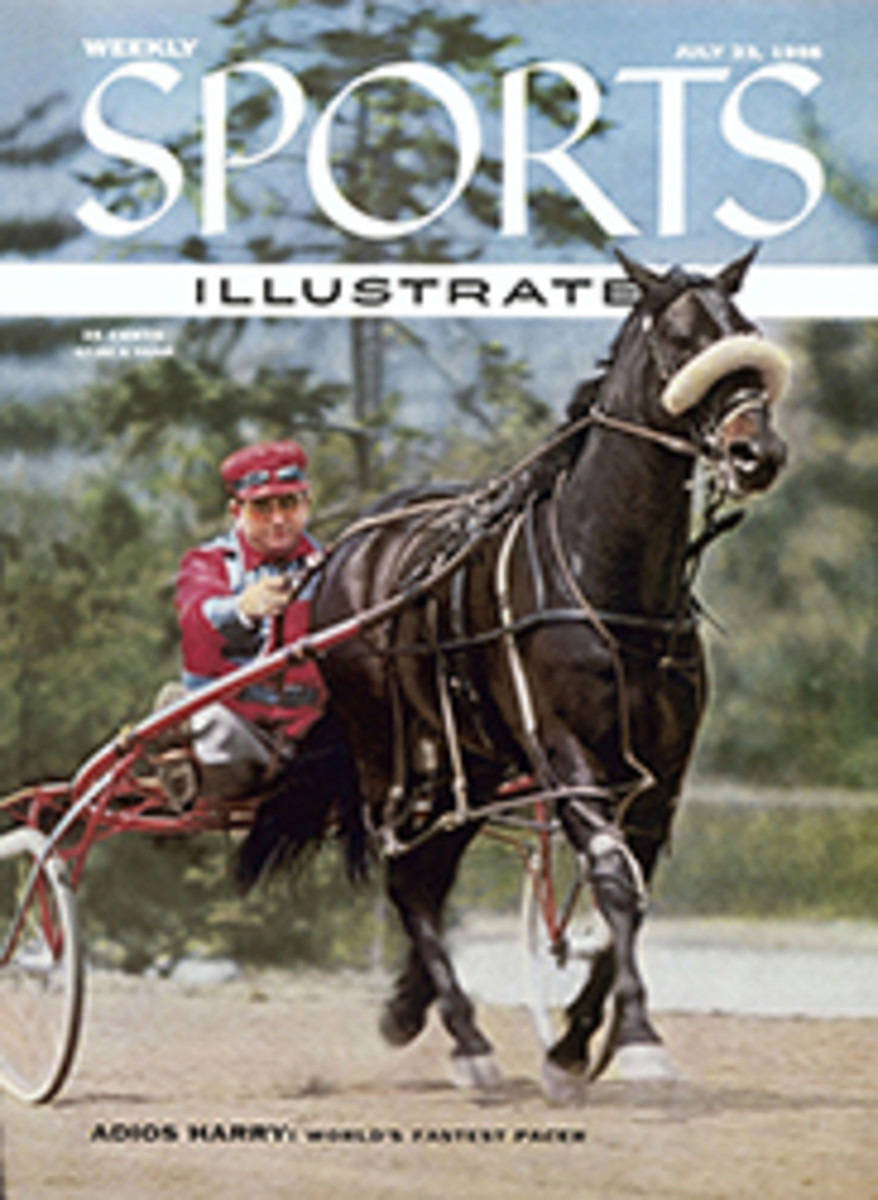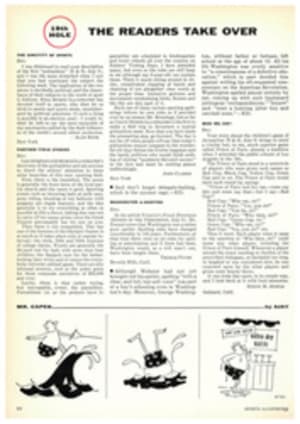
GOLF AND THE WOMEN
Back in those primitive days when even the men's locker room at Happy Knoll was without benefit of showers, Mrs. Charles Brown of Shinnecock Hills shot a 69 and a 63 and became our first Women's National Amateur champion. These happened to be her scores for the front and back nines, of course, but her total of 132 was low enough to carry the day back in 1895 when a field of 13 went at it at the old Meadow Brook Club to see who would be queen. Mrs. Brown's figures are extremely convenient ones for bringing out the distance women's golf has traveled over the past 60 years. Four springs ago, for example, when she was playing her first round in the Richmond Open in California, Patty Berg, after losing her way to the club, borrowing a sports shirt from a sister pro since she had forgotten her own, and having time to hit out only three or four practice shots, hurried onto the course and came within a shot of playing 18 holes in the same number of strokes it took the 1895 champ to play her better nine. After parring the first hole, Patty birdied the second when she cracked a four-iron a foot and a half from the pin, birdied the third when she cracked another four-iron two and a half feet away, and simply kept on rolling. On a sturdy par-72 course her card that day read 4-3-2, 4-3-3, 4-3-4, 4-2-5, 5-3-5, 2-4-4, which adds up to 64.
History is at best a sometime thing, and no one has the faintest idea when it was that women first played golf. We do know, though, that Mary, Queen of Scots, with her usual faulty sense of timing, was seen playing golf on the fields near Seton Castle only a short time after the death of Darnley. That was in 1567. For the next 300 years the references to women's golf are rare and muddied, but in 1867 the St. Andrews Ladies Golf Club was formed, others soon sprang up and so ended what the armchair brigade melancholically terms the Golden, or Quiet, Age of Golf.
In view of the trenchant way women today dominate the atmosphere at most of our country clubs, selecting not only the drapes and the flowers but the pro and the lifeguard, it is no easy effort to remember that they were a long time in achieving equal rights on and around the golf course. Their Sylvia Pankhursts were their great golfers who could not fail to be imitated by other women and to be admired by the men: Mrs. Dorothy Campbell Hurd, a Scots girl, who (circa 1910) won the Scottish, British, Canadian and American championships; Cecil Leitch, the first woman who decided that there was no reason a woman shouldn't attack the ball forcefully like the best men players, and who did so with such a natural dash; the incomparable Joyce Wethered, who succeeded Miss Leitch after World War I as the queen of the British links and is remembered as the most consummate of women stylists; Glenna Collett, the pertinacious girl from Providence, the first great American champion, who won our national title six times between 1922 and 1935, and in more recent years such superb players as Patty Berg and the majestic Babe Didrikson Zaharias who "made" women's professional golf after she had become in 1947 the first American to win the British Ladies Championship. (We have always called ours the Women's, Professor Henry Higgins not being around at the crucial moment to set us straight in this delicate matter.)
Who was the greatest of these? They all have their supporters, but most people who have had the privilege of seeing them all think it is a toss-up between the Didrikson of 1947 and the Wethered of 1924. We know the Babe well, so a word about Joyce Wethered probably would not be amiss. "From a quiet house or a secluded part of a hotel," so goes Enid Wilson's unforgettable cameo of Joyce, "she would come to the first tee, smile charmingly at her opponent when they met at the commencement of their game, and then, almost as though in a trance, become a golfing machine. She never obtruded her personality, and those who played her had the impression that they, the crowd and the state of the game had ceased to exist in her mind and that her entire faculties were being focused on swinging to perfection and holing the ball in the fewest number of strokes. The match concluded, Miss Wethered would vanish and be seen no more until the starter called her name for the next round."
THE CONTEMPORARY SCENE
Today a few clubs like Pine Valley, going further than even Happy Knoll, still contend that woman's place is the station wagon and bar them from the clubhouse and course except at visiting hours. However, that is the exception to the rule, and women's golf has reached the point where a steady stream of tournaments is now played by a band of touring professionals whom Betty Hicks introduces on the following pages. What is at least as remarkable as the women's pro circuit is the fact that no one any longer thinks this to be an unnatural state of affairs.
In 1946, with such a goodly number of women pros around who, of course, could not compete in the Amateur, the first Women's Open championship was instituted by the Ladies PGA. Next week, at the Northland Country Club in Duluth, the pros, joined by such outstanding amateurs as Wiffi Smith, will be meeting for their 11th annual Open championship, the fourth held under the auspices of the USGA. Men accompanied by tickets will be admitted, and many will be on hand, since, except for their inability to hit the ball quite as far as our male stars, the girls today have honestly attained a comparable degree of skill.

